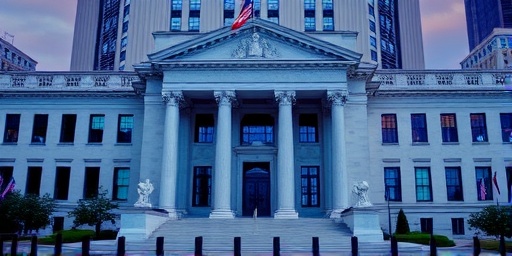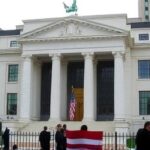U.S. stock futures plunged in pre-market trading on Monday, signaling a rough start to the week for global markets as Federal Reserve officials aired sharply diverging views on potential interest rate cuts. The discord, highlighted in recent speeches and interviews, has injected fresh uncertainty into an already volatile economy, with investors bracing for prolonged indecision from the central bank.
The Dow Jones Industrial Average futures dropped over 300 points, while S&P 500 and Nasdaq futures fell by 1.2% and 1.5% respectively. This sell-off echoed across international exchanges, with Europe’s FTSE 100 and Japan’s Nikkei 225 opening lower by 0.8% and 1.1%. The catalyst? A weekend flurry of comments from Fed policymakers that underscored a deep divide on the timing and extent of rate cuts, complicating expectations for monetary easing in the face of cooling inflation and uneven economic growth.
Fed Hawks and Doves Clash on Rate Cut Timeline
The Federal Reserve‘s internal rift became starkly evident over the weekend, as key officials delivered contrasting messages on the path forward for interest rate cuts. Fed Chair Jerome Powell, in a Saturday interview with CNBC, reiterated a data-dependent approach but stopped short of committing to cuts at the upcoming July meeting. ‘We need to see sustained progress on inflation before easing policy,’ Powell stated, emphasizing the risks of premature rate reductions amid persistent shelter costs and wage pressures.
Contrasting Powell’s measured tone, Atlanta Fed President Raphael Bostic emerged as a vocal hawk, arguing in a Bloomberg op-ed that the economy’s resilience warrants holding rates steady through at least the third quarter. ‘Inflation remains above our 2% target, and cutting too soon could reignite price pressures,’ Bostic wrote, citing recent CPI data showing a 3.4% year-over-year increase in core inflation. Bostic’s stance aligns with other regional presidents like James Bullard, who has historically favored a cautious pace to avoid overheating the stock market and broader economy.
On the dovish side, San Francisco Fed President Mary Daly painted a more optimistic picture during a panel at the Jackson Hole symposium’s precursor event. ‘With unemployment ticking up to 4.1% and consumer spending softening, rate cuts could provide a timely boost to growth,’ Daly remarked. Her comments echoed those of New York Fed President John Williams, who in a Friday speech suggested that ‘multiple cuts might be appropriate by year-end if data cooperates.’ This split among the Fed’s 19 policymakers—seven of whom vote on rates this year—has amplified uncertainty, as markets now price in only a 65% chance of a September cut, down from 85% a week ago, according to CME FedWatch Tool data.
The disagreement isn’t just philosophical; it reflects deeper tensions within the Federal Reserve over balancing inflation control with economic support. Recent economic indicators, including a 0.2% GDP contraction in the first quarter and robust job gains of 206,000 in June, have left officials grappling with mixed signals. This internal debate, rare in its public intensity, risks prolonging the uncertainty that has already shaved 2.5% off the S&P 500 in the past month.
Stock Market Sell-Off Ripples from Wall Street to Asia
The stock market’s immediate reaction to the Fed’s discord was swift and severe, with U.S. indices leading a global downturn. The S&P 500, often seen as a barometer for the economy, closed Friday down 0.9% but futures suggested an even steeper drop at open. Tech-heavy Nasdaq Composite, sensitive to interest rate expectations due to its growth stock composition, saw the sharpest declines, with futures pointing to a 1.8% plunge. Major players like Apple and Nvidia, which have driven much of the market’s 2024 gains, were hit hard in after-hours trading, falling 2% and 2.5% respectively on fears of higher-for-longer rates squeezing valuations.
Across the Atlantic, London’s FTSE 100 dipped into negative territory early Monday, dragged down by banking and energy sectors. Germany’s DAX index shed 1.3%, as investors worried about spillover effects on European exports amid U.S. economic uncertainty. In Asia, the reaction was equally pronounced: Hong Kong’s Hang Seng Index tumbled 1.7% at open, while Shanghai Composite edged lower by 0.9%. Japan’s Nikkei 225, already under pressure from a strengthening yen, extended losses to 1.4%, with automakers like Toyota dropping 3% on concerns over U.S. consumer demand.
Commodity markets weren’t spared, with oil prices dipping below $80 per barrel for WTI crude, down 1.2% on demand worries tied to a potentially sluggish economy. Gold, typically a safe-haven asset, surged 0.8% to $2,350 an ounce as investors sought refuge from stock market volatility. Bond yields reflected the unease too; the 10-year U.S. Treasury yield climbed to 4.35%, up from 4.25% last week, signaling bets on delayed rate cuts.
This synchronized global stock market retreat underscores the interconnected nature of modern finance, where Federal Reserve decisions reverberate worldwide. Analysts at Goldman Sachs noted in a morning note that ‘the Fed’s indecision is amplifying risk-off sentiment, potentially leading to a 5-7% correction in major indices if no clarity emerges soon.’
Economic Uncertainty Clouds Growth Outlook and Inflation Fight
Beneath the stock market turbulence lies a broader economic uncertainty fueled by the Federal Reserve’s rate cut deliberations. The U.S. economy, which expanded at a 1.6% annualized rate in Q2 per advance estimates, faces headwinds from high borrowing costs that have persisted since the Fed’s aggressive hiking cycle began in 2022. With the benchmark federal funds rate at 5.25-5.50%, consumers and businesses are feeling the pinch: mortgage rates hover around 7%, auto loans exceed 8%, and corporate debt refinancing costs have spiked.
Inflation, the Fed’s primary foe, has moderated from 9.1% peaks in 2022 but remains stubborn. The latest PCE price index, the Fed’s preferred gauge, rose 2.6% in May, just above the 2% target. Shelter inflation, accounting for a third of the CPI basket, climbed 5.2% year-over-year, while services prices ticked up due to labor shortages. Yet, dovish voices argue that the economy shows signs of cooling: retail sales grew only 0.1% in June, and manufacturing PMI slipped to 48.5, indicating contraction.
The uncertainty extends to employment, a key Fed mandate. June’s nonfarm payrolls added 206,000 jobs, but revisions downward for prior months and a rising quit rate suggest softening labor markets. Economists at the Conference Board warn that prolonged high rates could push unemployment above 4.5% by year-end, risking a mild recession. ‘The Fed’s hesitation on rate cuts is playing with fire,’ said Mark Zandi, chief economist at Moody’s Analytics. ‘It could tip the economy from soft landing to hard landing if growth stalls.’
Globally, the ripple effects are profound. Emerging markets, reliant on U.S. demand, face currency pressures; the Brazilian real and Indian rupee weakened 1% against the dollar Monday. In Europe, the ECB’s recent rate cut to 3.75% now looks premature if U.S. policy tightens the financial noose further. This economic uncertainty not only hampers investment but also erodes consumer confidence, as evidenced by the University of Michigan’s sentiment index dropping to 65.8 in July.
Investors and Analysts Brace for Fed’s Next Moves
Wall Street’s heavyweights wasted no time reacting to the Fed’s split, with hedge funds and institutional investors recalibrating portfolios amid the rate cut uncertainty. BlackRock CEO Larry Fink, in a weekend CNBC appearance, cautioned that ‘diverging Fed views are creating a fog of war for markets, leading to defensive positioning in bonds and defensives stocks.’ Indeed, sectors like utilities and consumer staples gained modest ground in Friday’s close, up 0.5% on average, as investors flee cyclical plays like industrials, which sank 1.2%.
Options trading volume surged 40% pre-market, with put options on the SPY ETF—tracking the S&P 500—outpacing calls for the first time in weeks. Retail investors, via platforms like Robinhood, pulled $1.2 billion from equity funds last week, per EPFR data, shifting toward cash and Treasuries yielding over 5%. ‘The stock market hates uncertainty, and the Fed is serving it up in spades,’ quipped Art Laffer, the economist behind the famous curve, in a Fox Business interview.
Expert commentary is rife with caveats. JPMorgan’s Michael Feroli predicts a ‘wait-and-see’ September meeting, with markets potentially stabilizing if July’s jobs report disappoints. Conversely, Deutsche Bank’s chief strategist, Henry Allen, foresees volatility persisting until the Fed’s September 17-18 gathering. Survey data from the National Association for Business Economics shows 62% of members expecting at least two rate cuts by December, but only if inflation dips below 2.5%.
Institutional flows tell a similar story: Vanguard reported $15 billion in inflows to its bond funds last week, while equity ETFs saw $8 billion in outflows. This rotation away from risk assets highlights how the Federal Reserve’s internal debates are reshaping investment strategies, with implications for retirement portfolios and corporate financing alike.
Path Forward: Eyes on Upcoming Data and Fed Meetings
As markets digest the fallout from the Fed’s disagreements, attention shifts to pivotal data releases and policy milestones that could clarify the rate cut trajectory. The July nonfarm payrolls report, due Friday, is expected to show 180,000 job additions; a miss could bolster dovish calls for immediate easing. ISM services PMI on Wednesday will gauge the economy’s service sector, which drives 70% of U.S. GDP.
The Federal Reserve’s next policy meeting on July 30-31 looms large, though most anticipate no change in rates. Powell’s post-meeting press conference will be scrutinized for hints on September’s prospects. Looking further, the Jackson Hole symposium in late August often serves as a sounding board for major policy shifts, potentially where rate cut details emerge.
Investors are also monitoring global cues: the Bank of England’s August decision and China’s stimulus measures could influence U.S. dynamics. If the Fed resolves its divide toward cuts—perhaps 25 basis points in September, followed by another in December—markets could rebound sharply, with the S&P 500 targeting 5,600 by year-end per consensus forecasts. However, persistent uncertainty might prolong the stock market’s malaise, testing the economy’s resilience and central bankers’ resolve.
In this environment, diversification remains key. Financial advisors recommend balancing equities with fixed income, as Treasury yields offer attractive returns amid rate cut delays. Ultimately, the Fed’s path will dictate whether this dip is a blip or the start of a deeper correction, with global growth hanging in the balance.









